The inability to physically be in Tampa, FL shouldn’t stop someone from participating in the ASHP Summer Meeting. Technology doesn’t care that I’m 2700 miles away or that I’m sitting in my home in my bunny slippers with Diet Pepsi in hand. With a webcam and speaker phone I was able to join a user group discussion held by Talyst.
I’ve mentioned before the importance of attending healthcare conferences, and while this wasn’t nearly as good as being there in person, it was certainly better than not being involved at all. User groups offer the chance to hear about new company products long before the information is released to the general public and give you the opportunity to commune with people in the same situation as you.
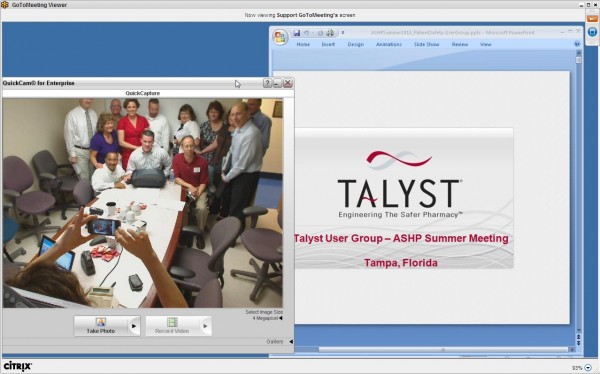
The main focus of this particular user group meeting was to discuss the Talyst Software Only Workstation (SOW) pilot that I’ve blogged about here, and here; introduce and review the new AutoPharm3 patient safety release; and discuss the new barcode scanning hardware that Talyst is planning on rolling out in the near future. In addition there were discussions on various issues ranging from customer best practices to utilizing the Talyst customer portal.
The SOW pilot presentation and discussion was led by Brian Peters, Pharm.D., Director of pharmacy, Community Hospital North in Indianapolis, IN. He described the use of the SOW system in a cardiovascular specialty hospital using CPOE, eMAR and digital imaging technology. His experiences with SOW were mostly positive and similar in many ways to what I’ve experienced with the system myself. He too felt that a solution that offered visual feedback when scanning items while out of sight of the AutoPharm workstation would be beneficial. Overall, the presentation went well and provided some good information.
The show stopper, however, was the presentation on the upcoming AutoPharm3 release. Talyst has been talking about this “patient safety release” for quite some time and based on what I saw today there are some great new features. In a nutshell the AutoPharm3 will offer:
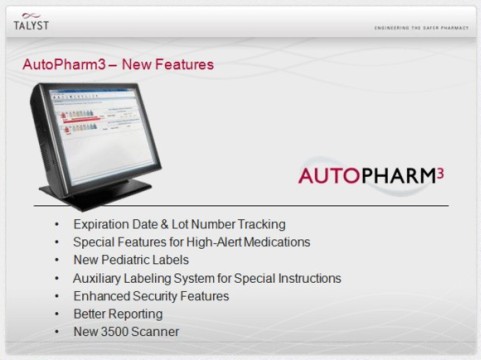
- Lot number and expiration tracking. For many facilities this won’t make much of an impact because they already utilize the expiration tracking function in their automated dispensing cabinets (ADC). On the other hand, the ability to track lot numbers is becoming increasingly important as recalls are giving everyone a giant headache. One could easily skip the expiration tracking in their ADCs in favor of using the lot and expiration tracking in AutoPharm. The benefit of using the AutoPharm system would be the reporting capabilities and the in-your-face way the system presents the information on the main dispensing screen.
- High alert medications. AutoPharm will now allow facilities to control messages for high alert medications at the formulary level. The functionality forces additional steps prior to dispensing a high-alert item and provides the end user with informational text on the label in the form of a watermark.
- Pediatric auxiliary labels for pediatric syringes. This is an interesting addition and one that I have discussed with various Talyst representatives in the past. I’m not sure where it fits in, but like many adult facilities pediatric medications can be challenging. Wait and see on this one.
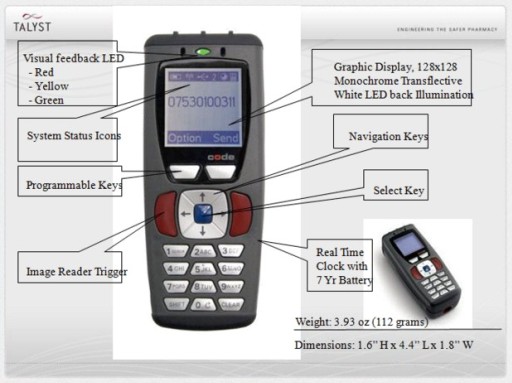 New role based permissions. This feature will be a welcome addition as it is a glaring hole in the current AutoPharm release. The current permissions structure in the AutoPharm system offers little flexibility and creates some workflow issues. This new feature will offer additional flexibility to users of the system. Looking forward to this.
New role based permissions. This feature will be a welcome addition as it is a glaring hole in the current AutoPharm release. The current permissions structure in the AutoPharm system offers little flexibility and creates some workflow issues. This new feature will offer additional flexibility to users of the system. Looking forward to this.- New reporting. This is something that I’ve been waiting on for a while. Quite frankly it has been a weakness of the system until very recently. New reports include high alert medication tracking, expired drug reports, lot number tracking, inventory adjustment report, i.e. discrepencies, and improper scan reports. That last one is the one I’ve been after for a while. I call them bad scans, but it’s the same idea. The report basically tells you how many times the system intercepted someone pulling the wrong drug. It’s a basic concept, but one that you can drill into to find out quite a bit about workflow.
- The new Code 3500 scanner. Tony North from Talyst spent quite a bit of time going over the new Code Corp 3500 scanner. He presented the advantages that the 3500 offers over the older CR3. In addition, he dissected the technology and presented some of the new features offered by the scanner. I’ve talked about the Code Corp 3500 scanner before. It is significantly better than the current CR3 scanner used by most Talyst customers. I’m fortunate that I’ve been using the 3500 for several months. End users will appreciate the upgrade.
Overall I picked up quite a bit by “attending” the 2010 Talyst user group meeting at the ASHP summer session. It was a little weird watching everyone on the monitor and I had trouble hearing at times, but as I said before it was better than missing the whole thing. There were a couple of times when the screen was filled with a slide and I continued to hear everyone, but couldn’t see them. It actually felt strange not being able to see everyone during those periods. I felt like I was more engaged when I could see what was going on at the table. Anyone else ever experience anything like that?
Below are several screen shots I took during the user group. There isn’t anything spectacular about them, but I thought I would include them for anyone that was interested. Enjoy.



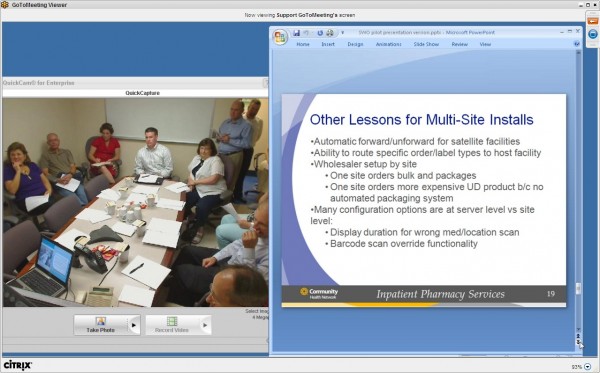
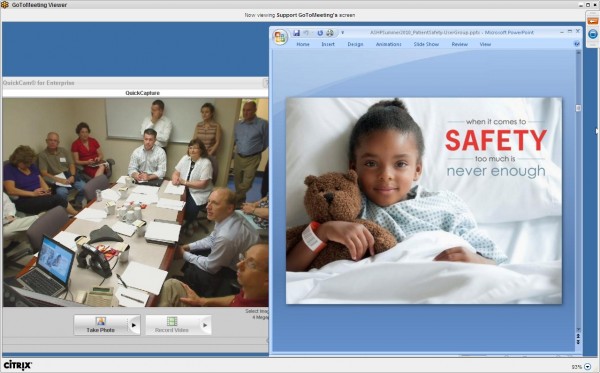


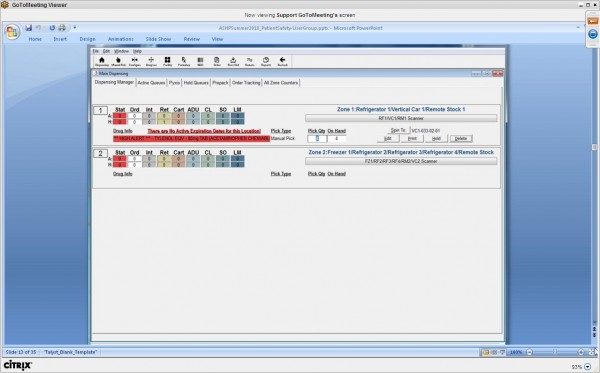

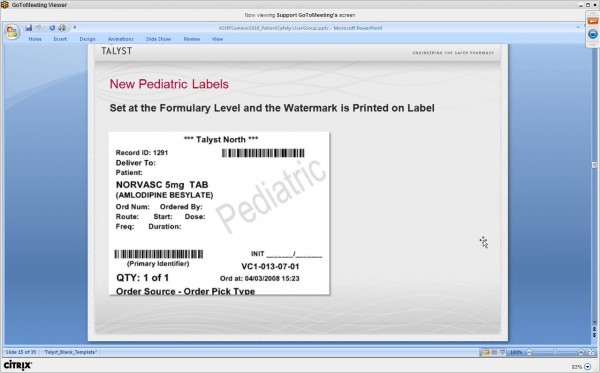
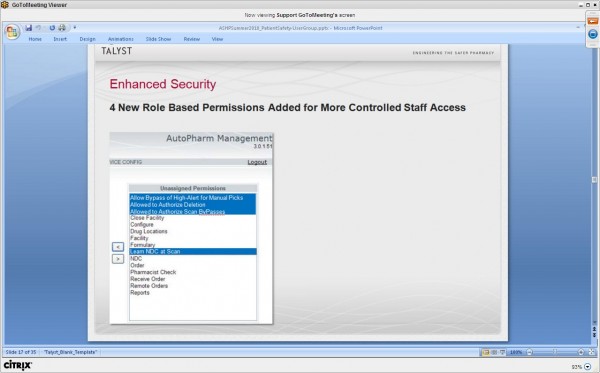

2 thoughts on “Participating in the ASHP Summer Meeting from afar #ashpsm10”